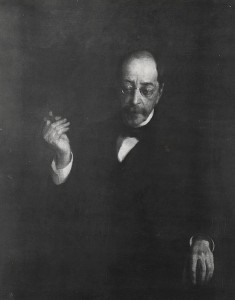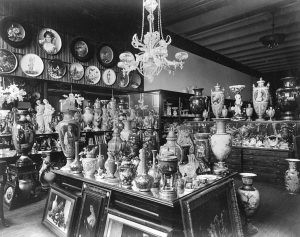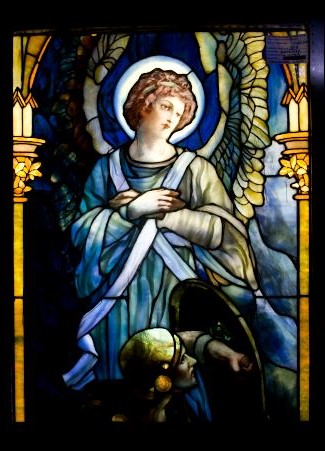
Image of John LaFarge, the innovator who created Opalescent Glass.
The Christ Resurrection window is a triple lancet window that uses a variety of techniques to achieve its ethereal appearance. It is an ecclesiastical window that was created by a designer named Frederick Wilson (1858-1932) who specialized in the design of windows such as these. Marion J. Dimmock was the architect that designed the first All Saints Episcopal Church for which the windows were made. This structure, completed in 1888, was intended to fit in with a Romanesque Revival style¹.
This leaded and plated glass window is supported by a wood frame and fortunately the whole piece is in relatively good condition. Paint is still intact on its surface. Although after its re-discovery, it had to undergo intense cleaning.
This work also features flashed glass, drapery glass and feathered glass. Cabochons, small round glass jewels, are used to accessorize the figures. All these types of glass together create an awe-inspiring image. Tiffany advocated little use of painting on glass because he felt it interfered with the filtering of light.

Tiffany and Company storage area in Union Square.painted glass on this window.
During the late 19th century when this window was created, Tiffany was intent on finding new ways to manufacture glass. He worked to achieve a patent for creating opalescent glass, an innovative technique that creates a milky color in the glass. Tiffany encouraged his artisans to mix and experiment with colors for an original take on stained glass windows. These new techniques emphasized the versatility of glass rather than limiting it to a surface for painting. Tiffany strongly advocated that skilled artisans be involved at every stage of a window’s creation. He oversaw each stage, from design to production. This was crucial to ensure the quality of his windows. Not only did he watch over the work being done, he had a staff with a defined hierarchy for his artists. Tiffany had a well-oiled system for manufacturing works of art by artists and this, in turn, led to the exceptional quality of his windows.
Discovering the Glass Used the Windows
Footnotes
¹ The Romanesque Revival style was an architectural style inspired by ancient Roman architecture but with added drama and strength such as wider arches, sculptural form, and heavy stone or brick usage.
Citations
“Louis Comfort Tiffany.” The Charles Hosmer-Morse Museum of American Art. Accessed May 7, 2015. http://www.morsemuseum.org/louis-comfort-tiffany.
“Romanesque Revival Style 1840-1900: Common Building Types: Houses, churches, government offices, schools, banks, commercial buildings.” Pennsylvania Historical & Museum Commission. Accessed May 23, 2015. http://www.portal.state.pa.us/portal/server.pt/community/late_victorian_period/2389/romanesque_revival_style/294764.
“Secrets of Tiffany Glassmaking.” The Charles Hosmer-Morse Museum of American Art. Accessed May 7, 2015. http://www.morsemuseum.org/on-exhibit/secrets-of-tiffany-glassmaking.

Exploring Tiffany Windows.
Ready to learn more? Following the links below to explore!
